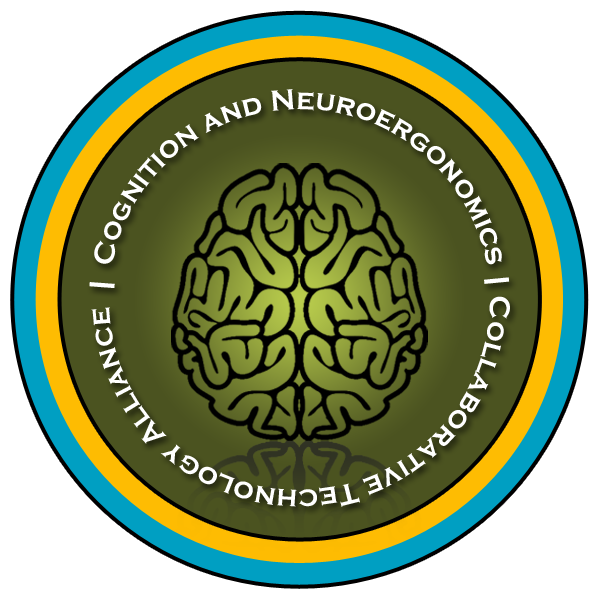Organization
Modern neuroscience research is a truly multi-disciplinary endeavor. Across the world’s leading research institutions, neuroscience research is conducted by scientists from diverse fields, including, but not limited to: neuroscience and neurobiology, genetics, psychology, kinesiology, statistics, applied mathematics, physics, computer science, and engineering. These research efforts depend upon the kinds of collaborative relationships that are at the heart of ARL’s Collaborative Technology Alliances (see text box, “The CTA Concept”). And with partners from Taiwan to Germany, the Cognition and Neuroergonomics Collaborative Technology Alliance (CaN CTA) truly embodies the CTA concept, bringing together leading researchers from world-class research organizations from around the globe.

Led by its industry partner, DCS Corporation, the CaN CTA Consortium includes institutions that are widely-recognized as leaders in the academic research world. Five of the academic partners currently in the CaN CTA are ranked in the top 1% of world’s most productive research institutions (SIR World Report survey 2014), and three of them are also in the world’s top 10 universities for neuroscience and behavior (US News & World Report survey 2014).
Programmatics
Established in May 2010, the CaN CTA was awarded an optional five year extension and is executing the option period of the program. The CaN CTA is formalized via a Cooperative Agreement with the Consortium member institutions, as a whole, to fund its program of basic research, and also through a Technology Transition contract awarded to DCS Corporation as the CTA’s industry lead (see Opportunities for further information).
The CaN CTA is led by Program Director, Mr. Tim Lee (DCS Corp.), and Cooperative Agreement Manager (CAM), Dr. Jonathan Touryan (ARL). Dr. Touryan also serves as the Contracting Officer’s Representative (COR) for the CaN CTA’s Technology Transition contract (see “Opportunities” for more information). Due to the increasing depth and breadth of the research, scientific guidance of the collaborative research has been subdivided by Science Areas (explained under the Technical Program) to Dr. Scott Makeig (UCSD), Dr. Tzzy-Ping Jung (UCSD), Dr. Paul Sajda (Columbia), and Dr. Daniel Ferris (U. Mich), with corresponding leadership from ARL scientists, Dr. Piotr Franaszczuk, Dr. Brent Lance, and Dr. W. David Hairston.
Program decisions are governed by the Consortium Management Committee (CMC), comprised of one voting member from each of the Consortium members (for current CMC membership, see names in bold, below). The CMC is chaired by Mr. Lee, with the ARL CAM acting as an ex officio member. The CMC is responsible for all programmatic, technical, financial, and administrative matters pertaining to the CaN CTA program.
Sub-Awardee Partners
As a requirement of the CaN CTA Cooperative Agreement, the Government reserves the right to withhold up to 10% of funding and to award those funds to selected proposals submitted to the Government in line with the objectives of the CTA program. These “seedling” project awards are meant to provide the Alliance with the flexibility to pursue high-risk, high-payoff research approaches that address research gaps in the CaN CTA technical program. During the execution to date, the Government has invited proposals from promising researchers for evaluation at various times of program planning, and some of those research efforts have led to elevation of the sub-awardee to full membership in the CaN CTA consortium.
The CTA Concept
Equipping the Army’s future force with capabilities that allow us to maintain our tactical and strategic advantages will require ongoing research investments that support the rapid transition of innovative technologies from cutting-edge basic research to fielded solutions. ARL’s Collaborative Technology Alliances (CTA) concept brings world class research and development talent among academia, private industry, and Army laboratories and centers, together to focus on Army technology objectives.
Active collaboration among the three CTA components is a key element: Academic research labs are the country’s storehouse of basic science innovation; Industry partners have unique capabilities and relationships needed to leverage existing research results into technology transition; and Army scientists and engineers bring both research skills and a Soldier-centric focus to keep programs oriented toward solving complex Army technology challenges. By combing the distinctly different approaches, perspectives, and capabilities of their multidisciplinary teams, CTAs are generating the advances required to meet the needs of the Army’s future force.
CaN CTA Membership
(current Consortium Management Committee in gold)
US Army Research Laboratory
Aberdeen Proving Ground, MD
DCS Corporation
Alexandria, VA
University of California San Diego
San Diego, CA
National Chiao Tung University
Hsinchu City, Taiwan
University of Michigan
Ann Arbor, MI
University of Osnabruck
Osnabruck, Germany
University of Texas San Antonio
UTSA Research ||
Yufei Huang
San Antonio, TX
Carnegie Mellon University
Pittsburgh, PA
Columbia University
New York, NY
University of Pennsylvania
Dani Bassett ||
Communication Neuroscience Lab
Philadelphia, PA
Johns Hopkins University
Baltimore, MD
Syntrogi
San Diego, CA
Data Nova
Niskayuna, NY

